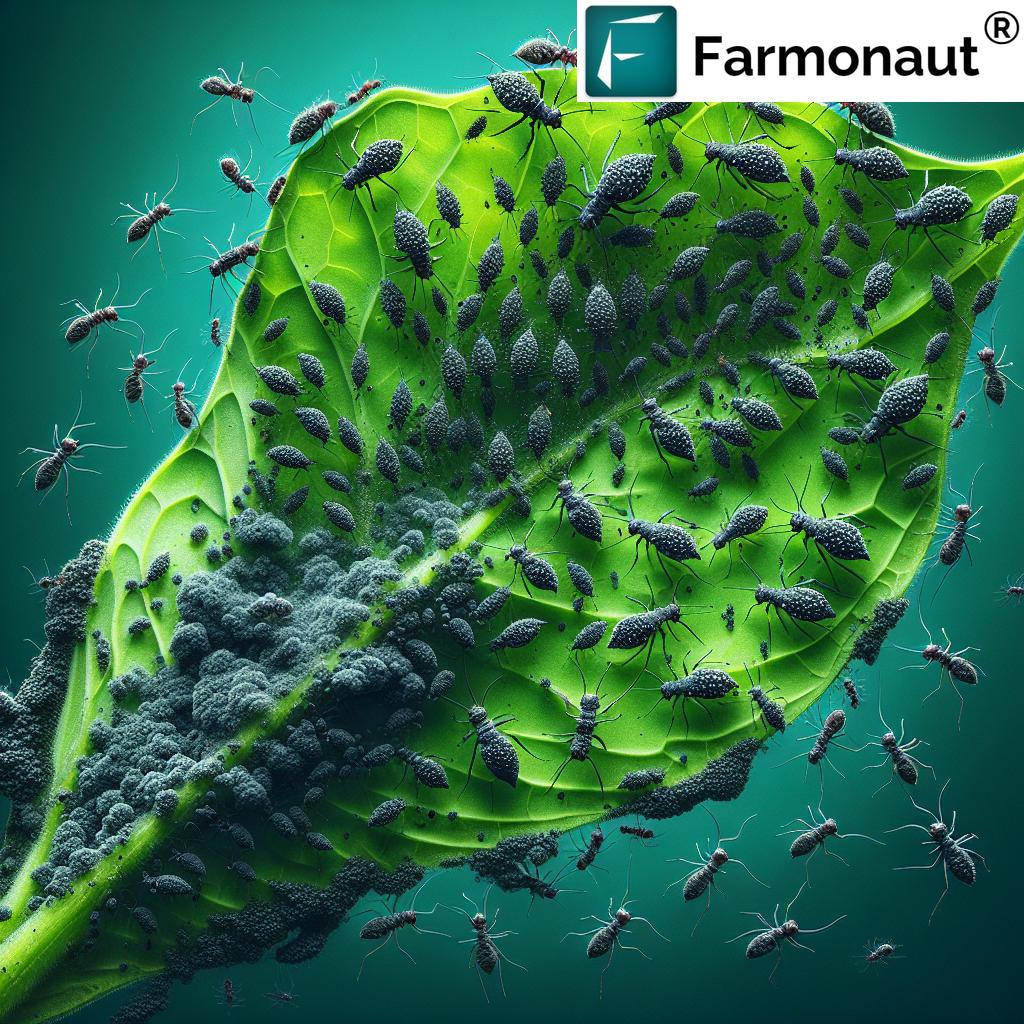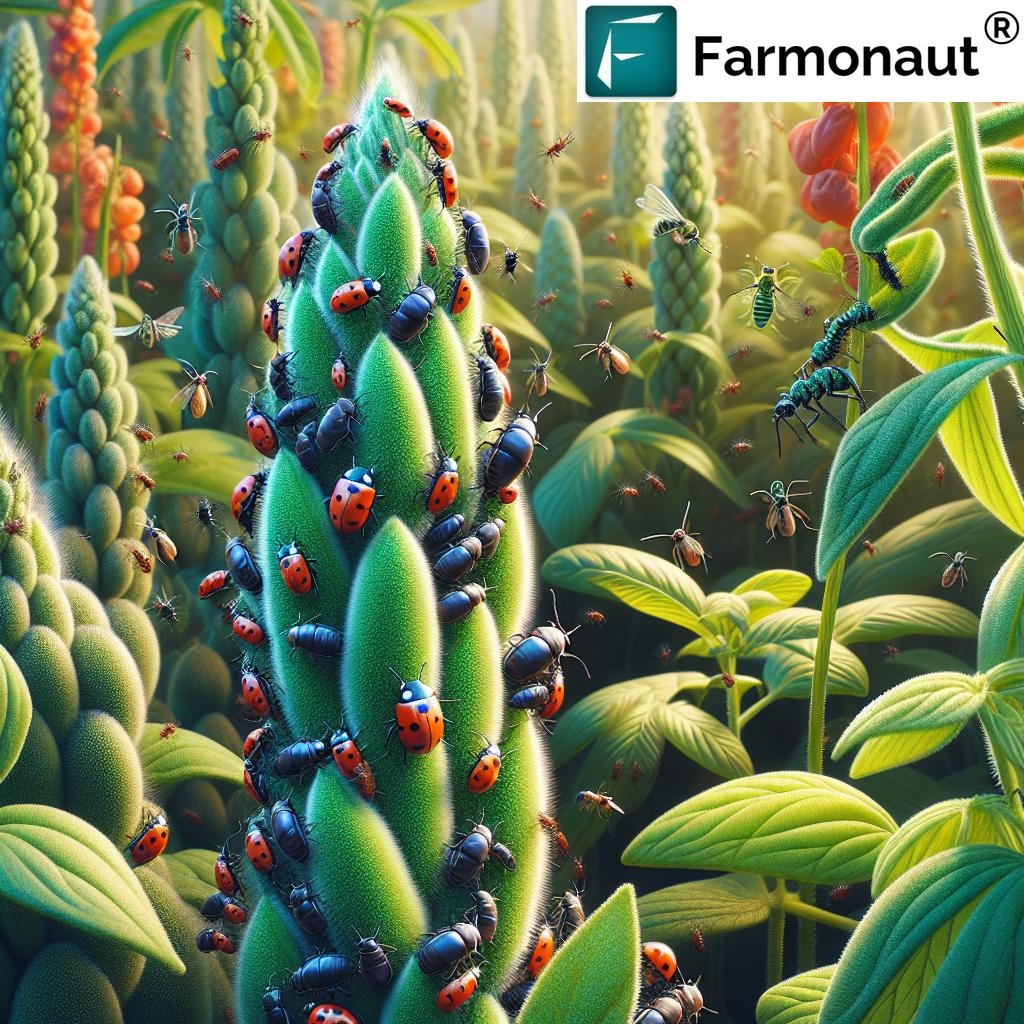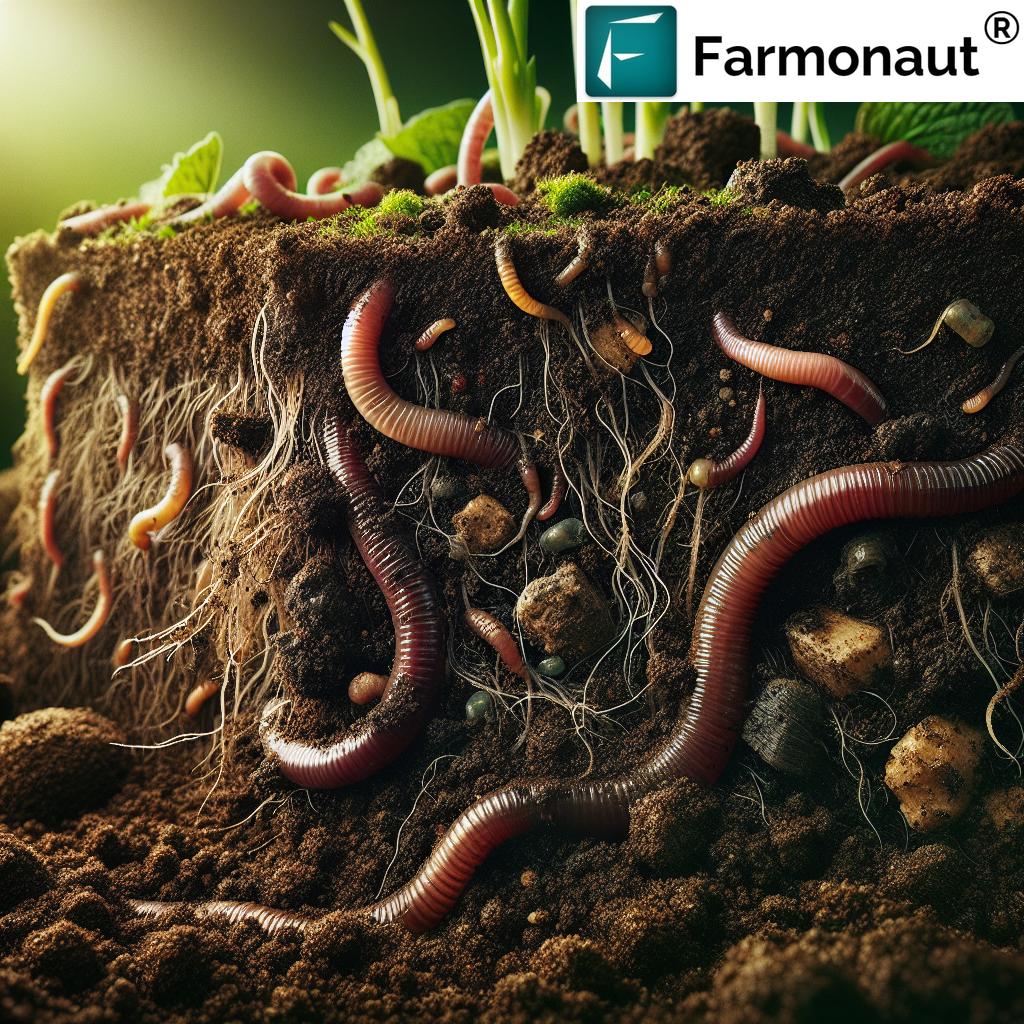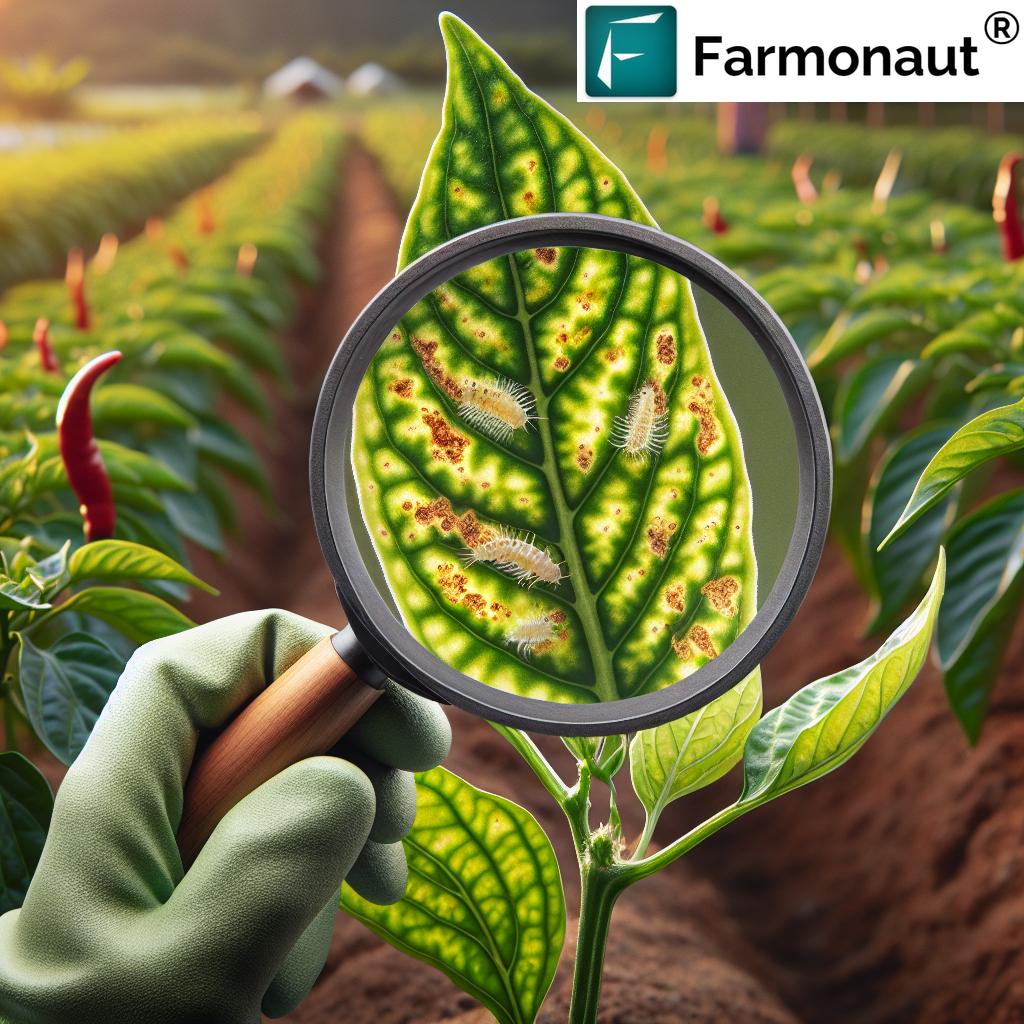Small Black Aphids: 7 Ways to Control and Protect Plants
Small black aphids are notorious insect pests that threaten a broad range of plants in agriculture and forestry. For both commercial farmers and home gardeners, these **tiny but destructive insects** can cause severe yield losses, transmit dangerous plant viruses, and lead to unsightly honeydew and sooty mold on plants. Effective management requires understanding their biology, identifying problem species, and adopting a combination of proven aphid control methods.
In this comprehensive, SEO-optimized blog (over 3,500 words), we’ll guide you through effective aphid infestation management – from small black aphids identification to cultural, biological, and chemical control strategies. We’ll also demonstrate how solutions like Farmonaut’s digital crop health monitoring platform can empower farmers with real-time pest management insights. Let’s make our crops, trees, and landscapes healthier by tackling aphids head-on, using fact-based, sustainable, and integrated approaches.
Aphid Biology & Small Black Aphids Identification
Aphids, including the small black aphids commonly seen in agricultural and forestry settings, are sap-extracting insects that harm plant health through their unique feeding habits and reproductive abilities. Let’s explore how to recognize these pests, understand their life cycle, and distinguish them from other plant insects.
General Characteristics of Aphids
- Size: Most aphids are less than 1/4 inch (about 2–4mm) in length.
- Shape: Typically pear-shaped bodies; some appear more rounded, especially in the wingless adult stage.
- Color: Small black aphids are generally shiny black, dark brown, or charcoal grey.
- Mouthparts: All aphids possess piercing-sucking mouthparts – needle-like structures used to penetrate plant tissue and extract sap.
- Unique Features: Two cornicles (tube-like projections) near the hind end are visible on most species, used to secrete defensive fluids.
Small Black Aphids Identification: Key Species
Several aphid species are commonly observed as small black pests impacting fields, orchards, and forests:
-
Cowpea Aphid (Aphis craccivora):
- Hosts: Predominantly found on legumes (e.g., alfalfa, peanuts, cowpeas) but may also infest various vegetables and weeds.
- Appearance: Glossy black body, sometimes with a slight bluish sheen.
- Key Damages: Causes stunted growth, wilting, and can inject plant toxins. Produces honeydew that promotes sooty mold.
- See more from UC IPM.
-
Black Stem Aphid (Cinara confinis):
- Hosts: Coniferous trees, especially firs, spruces, and junipers.
- Appearance: Dull black, slender body, often grouped on stems or branches.
- Key Damages: Feeds on phloem, causing needle discoloration and shoot dieback. Honeydew supports sooty mold growth.
- Find details at Wikipedia.
-
Woolly Apple Aphid (Eriosoma lanigerum):
- Hosts: Apple trees and occasionally other fruit trees.
- Appearance: Small dark aphids covered by dense white, waxy “wool.” Found in cottony clusters along roots, branches, or wounds.
- Key Damages: Promotes leaf curling, branch galls, weakens vigor, causes yield decline, and may result in tree mortality if unchecked.
- Learn more at Wikipedia.
Besides these, there are numerous regional black aphid species. Regular field scouting is essential for early aphid infestation management.
How to Interpret Satellite Data for Agriculture – Farmonaut Mobile Apps
Life Cycle of Small Black Aphids
- Reproduction: Aphids can reproduce both sexually and asexually. Most generations are produced through parthenogenesis (females giving birth to live young without mating).
- Speed: Generations can complete in as little as 7–10 days under warm, humid conditions—making rapid population explosions possible.
- Colonies: Populations cluster on tender growth, under leaves, stems, flowers, and developing pods or fruits.
Impact of Aphids on Agriculture, Forestry, and Horticulture
The impact of aphids on agriculture and forestry extends beyond simple sap loss. These insects inflict direct feeding damage, trigger development of honeydew and sooty mold on plants, and act as vectors for viral disease, thereby compounding their detrimental effects.
Direct Feeding and Sap Extraction
-
Wilting & Stunting:
Aphid feeding extracts vital nutrients (sugars) from plant phloem, causing leaves to wilt, curl, and drop prematurely. -
Stunted Growth:
Persistent feeding leads to poor growth, flower/fruit drop, and weaker plant structure. -
Reduced Yields:
Affected crops show lower productivity and compromised quality, directly impacting harvest profits.
Honeydew Production and Sooty Mold Hazard
- As aphids extract sap, they excrete excess sugars as honeydew — a sticky residue on leaves, stems, and fruit.
- Honeydew and Sooty Mold on Plants: Honeydew acts as a substrate for sooty mold fungi, leaving surfaces coated with black, velvety mold.
- Photosynthesis Hindrance: Sooty mold blocks sunlight from reaching chloroplasts, reducing plant photosynthetic activity and overall vigor.
Aphids as Vectors: Spreading Plant Viruses
-
Transmission Role:
Aphids transmit over 200 plant viruses by feeding on infected plants and then rapidly moving to new hosts. -
Disease Examples:
- Cucumber mosaic virus
- Potato virus Y
- Barley yellow dwarf virus
These multi-layered threats make aphid control methods essential for sustainable agriculture, healthy forests, and thriving gardens.
Explore Farmonaut’s Advanced Crop Monitoring & Yield Prediction
7 Ways to Control Small Black Aphids and Protect Plants
Aphid infestation management involves adopting a tailored combination of controls. Below are the seven most effective methods, blending traditional wisdom with modern innovations to deliver comprehensive aphid control methods for plants, trees, and crops:
1. Cultural Controls
- Crop Rotation: By changing the types of plants grown in each field seasonally, we disrupt aphid life cycles and minimize host plant availability. This is effective for both open field agriculture and orchards.
- Pruning and Sanitation: Removing heavily infested plant parts can reduce immediate populations. Regular cleaning of orchard floors also minimizes overwintering spots.
- Weed Management: Keeping fields, fence lines, and field edges weed-free eliminates alternative aphid hosts and breeding grounds.
- Water Management: Adequate but not excessive irrigation keeps plants resilient, reducing aphid impact.
2. Biological Control of Plant Pests
-
Natural Predators of Aphids:
- Lady beetles (larvae and adults),
- Green lacewing larvae,
- Hoverfly larvae, and
- Parasitic wasps (e.g., Aphidius spp.)
Consistently protecting and encouraging these predators is crucial for long-term aphid control.
- Releasing Beneficial Insects: In severe infestations, mass-releasing commercially available predators boosts natural aphid reduction.
3. Chemical Controls
- Insecticidal Soaps and Oils: Horticultural oils and insecticidal soaps disrupt aphid cell membranes upon contact, killing them safely while sparing beneficial insects when used according to guidelines.
- Systemic Insecticides: In high-value or severe scenarios, systemic (plant-absorbed) insecticides are an option. These should be used judiciously, rotating active ingredients to prevent resistance and minimize negative environmental impact.
For responsible application techniques, see this guide.
4. Monitoring and Threshold-Based Action
- Scouting and Early Detection: Regular field walks and detailed scouting let you spot aphids before populations explode.
- Economic Thresholds: Apply controls only when aphid numbers hit levels that risk significant yield or tree loss, ensuring cost-effective, responsible management.
5. Physical Barriers and Exclusion
- Row Covers & Netting: Especially for seedlings and early vegetative crops, physical barriers protect against initial aphid infestations without chemicals.
- Reflective Mulches: Using silver-colored plastic mulch can deter landing aphids by confusing their orientation.
6. Managing Mutualist Ants
- Why Control Ants? Ants “farm” aphids for honeydew and zealously protect them from natural predators. Reducing ant activity (e.g., using sticky barriers) increases aphids’ vulnerability.
- Physical and Bait Trapping: Use baits and tree trunk sticky bands to cut off ants’ access, amplifying the effectiveness of biological aphid controls.
7. Integrated Pest Management for Aphids (IPM)
- IPM Philosophy: Integrate all the above approaches — cultural, biological, physical, chemical, and regular monitoring — for sustainable, long-term aphid suppression.
- Rotate Methods: Rotating or combining approaches discourages pesticide resistance and pest adaptation.
- Documentation: Record which methods are most effective on your farm or forest each season and tailor the plan as needed.
Satellite & AI Based Automated Tree Detection For Precise Counting and Location Mapping
Farmonaut Automated Detection of Alternate Wet and Dry Farming Phases
Comparison Table: Aphid Control Methods
| Control Method | Description | Estimated Effectiveness (%) | Estimated Cost (₹/treatment) | Application Frequency | Environmental Impact | Ease of Implementation |
|---|---|---|---|---|---|---|
| Cultural Controls | Crop rotation, pruning, weed management, optimal irrigation | 40–60% | Low (₹500–1,500/ha) | Seasonal/Ongoing | Low | Moderate |
| Biological Controls | Encourage/release lady beetles, lacewings, parasitic wasps | 50–80% | Medium (₹2,000–7,000/ha for releases) | 1–2 times per season or as needed | Low | Moderate |
| Chemical Controls | Insecticidal soaps, horticultural oils, systemic insecticides | 70–95% | Variable (₹500–5,000/ha) | As needed (max 2–3 times/season) | Medium–High | Easy–Moderate |
| Monitoring & Thresholds | Regular scouting and population-based action | 30–50% (indirect), increases timely intervention | Low (₹300–600/ha) | Weekly/during main growth | Low | Moderate |
| Physical Barriers | Row covers, reflective mulches, fine screening | 60–75% | Medium (₹1,500–4,000/ha) | At planting or seedling stage | Low | Moderate |
| Ant Management | Sticky bands, ant baits, exclusion techniques | 30–60% (improves biological control efficacy) | Low–Medium (₹800–2,000/ha) | Ongoing during aphid season | Low | Easy–Moderate |
| Integrated Pest Management (IPM) | Combines all above, adjusts per monitoring data | 80–98% | Varies (₹1,000–6,000/ha) | Dynamic; as needed | Low–Medium | Complex |
Integrated Pest Management for Aphids: A Comprehensive Strategy
Modern aphid infestation management favors integrated pest management for aphids (IPM), combining multiple approaches:
- Cultural Controls reduce aphid migration and reproduction naturally, providing a foundational layer of protection.
- Biological Control of Plant Pests harnesses allies like lady beetles and parasitic wasps.
- Judicious Chemical Use is reserved for threshold-exceeding outbreaks, following label instructions and rotating actives to avoid resistance.
- Physical Barriers are recommended for young or high-value crops.
- Regular Monitoring ensures early warning, allowing for timely, targeted response.
- Ant Management amplifies the effect of biological agents, improving overall strategy effectiveness.
- Documentation and Adjustment are crucial. Keep records of aphid hotspots, methods used, and relative success to continually refine your approach.
For large-scale plantation and forest management advice—including detecting pest outbreaks, soil health, and more—visit our Crop Plantation & Forest Advisory page.
Preventing Aphids on Crops: Proactive Measures
Best Practices to Prevent Aphid Infestation
- Inspect New Plants: Examine all new transplants for any signs of aphids before introducing them into fields or orchards.
- Avoid Excess Fertilizers: Especially nitrogen—lush, rapid growth attracts aphids.
- Install Row Covers: Particularly in seedling and early transplant stages to physically exclude migrating aphids.
- Control Ants: Learn how ants can protect aphids and why breaking this relationship is critical.
- Encourage On-Farm Biodiversity: Install wildflower strips, hedgerows, and beetle banks to attract and retain natural predators of aphids.
Assure product quality and supply chain transparency – see how Farmonaut’s Blockchain Traceability Solution can authenticate pest-free, high-value crops for global markets.
Interested in the sustainable impact of different pest management strategies? Learn how our Carbon Footprinting Solution helps growers reduce the use of high-impact chemicals, contributing to eco-friendly agriculture.
Leveraging Digital Tools: How Farmonaut Supports Aphid Infestation Management
Timely detection and strategic response are crucial for effective aphid infestation management. At Farmonaut, we empower growers, agribusinesses, and foresters worldwide by offering:
- Real-time satellite crop health monitoring to detect early signs of pest-induced crop stress such as aphid colonization.
- AI-based advisory tools (Jeevn AI) that deliver personalized recommendations, prompt pest alerts, and suggest relevant aphid control methods.
- Blockchain-based traceability to guarantee buyers that your products meet pest and disease-free requirements.
- Resource management – get dynamic data-driven guidance for the optimal deployment of controls, reducing costs and minimizing unnecessary pesticide application.
In our platforms, both via mobile apps and web tools, users access NDVI analytics, irrigation advice, and precise field scouting maps – tools that form the backbone of modern integrated pest management for aphids.
For developers and research institutions: Integrate agronomic and weather data into your systems with our Farmonaut API or review our Developer Documentation for robust, scalable access.
Insurance and Finance: Mitigate the financial risk of aphid-induced crop damage by leveraging satellite-based monitoring for crop loan and insurance verification. Learn more.
Large-scale agribusinesses: Automate fleet management to optimize pest scouting visits and coordinate timely intervention over thousands of hectares with minimal resource wastage.
Forest managers: Detect aphid outbreaks on conifers using our Large Scale Farm Management Admin App for centralized monitoring across plantations, parks, or state forests.
Frequently Asked Questions about Small Black Aphids
How do I recognize a small black aphid versus other insects?
Small black aphids are generally shiny or matte black, with pear-shaped bodies, two visible cornicles (tubes) near their tail, and a tendency to cluster on stems and leaf undersides. They are slow-moving and soft-bodied, unlike beetles or thrips.
Can aphids damage trees as well as crops?
Yes. Species like the black stem aphid (Cinara confinis) and woolly apple aphid (Eriosoma lanigerum) commonly infest conifers and apple trees, causing dieback, discoloration, and increased vulnerability to other diseases.
What attracts aphids to certain plants?
Aphids seek young, lush growth, especially in fields over-fertilized with nitrogen. Some plants also naturally emit attractant volatiles. Weedy fields serve as reservoirs for aphid populations.
Are chemical insecticides safe for beneficial insects?
Insecticidal soaps and oils, applied per label, are generally safe for beneficial insects if not sprayed directly upon them. Systemic insecticides should be used as a last resort, and always in a targeted, responsible manner to minimize non-target impact.
How quickly should I respond to an aphid infestation?
Early response is key, as aphid populations can double every few days under favorable conditions. Begin with cultural and biological controls, monitoring both pest and beneficial insect numbers closely.
How do ants influence aphid populations?
Ants protect aphids in exchange for honeydew. By disrupting ant access via baits or sticky bands, aphids become much easier targets for their natural predators.
Can satellite or digital tools help in managing aphids?
Absolutely. Using digital crop monitoring tools (like those from Farmonaut), growers can visualize stress patterns, estimate infestation zones, and receive timely, data-driven pest control recommendations to minimize aphid damage.
Conclusion: Towards Aphid-Free, Healthier Crops and Trees
Small black aphids pose a persistent threat to the growth and productivity of crops, trees, and even entire forestry ecosystems. By mastering small black aphids identification, understanding their complex feeding behaviors, and implementing a robust, multi-faceted approach using the best aphid control methods, we can mitigate plant loss, reduce honeydew and sooty mold outbreaks, and maintain healthy, sustainable food production.
The era of digital agriculture, as advanced by Farmonaut’s satellite-driven solutions and AI advisory, empowers every farm manager—whether working with a few beds or tens of thousands of hectares—to monitor, analyze, and control pest populations with new agility and precision.
Protect your harvests, minimize ecological and economic impacts, and embrace next-generation management—so a single aphid never gets the upper hand in your fields or forests again.
Farmonaut Subscription Options
Access Farmonaut’s affordable, scalable, and cutting-edge platform for farm and plantation monitoring, all via easy subscription. Choose your model below:













